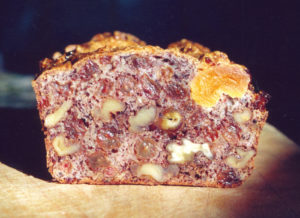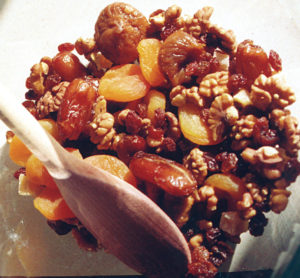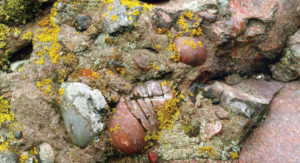By Susanna van Rose
Britain has lots of pebble beaches. What happens to these huge collections of shingle when they turn into rock? SUSANNA VAN ROSE explains by using a fruit and nut cake you can make at home.
What is a conglomerate?
A real, proper conglomerate should be made of rounded pebbles, some of which touch each other. In between the pebbles is fine-grained material, often sandy in texture, which holds everything together. Because it looks kind of like a pudding, an old-fashioned name, puddingstone, is sometimes still used. A similar rock is breccia, but in breccia, the rocky fragments have sharp, defined edges – they are angular.
Some conglomerates or breccias are matrix-supported – this would be like an ordinary fruit cake or a currant bun with lots of cakey stuff holding everything up, and a few currants scattered. In a matrix-supported cake you do have to worry about the fruit pieces all sinking to the bottom. But if they do, all is not lost, geologically speaking, because there are some rocks just like that.
Such rocks have conglomerate at the bottom of the layer, grading up into sandstone. Because the pebbles were originally at the bottom of the layer, these rocks are very important in helping geologists work out which way up a sequence of rocks is. If they’ve been folded or tilted, it is not always obvious which was the original topside.
To make a puddingstone, conglomerate or breccia cake, here is a seriously easy recipe that you can make for a special occasion:
You will need:
The oven set to 170 degrees
A loaf tin approximately 20 x10 cm, greased and lined
600 gm of dried fruit* and nuts**
4 eggs
100 gm honey or sugar
100 gm ground almonds
half tsp baking powder
some warmed apricot jam or marmalade
* You can use any combination of fruit and nuts you like. Whole dried figs, dates, apricots, cherries, walnuts, brazil nuts, pineapple chunks, whatever you have in the store cupboard, this cake is great for using up any (unsalted) fruit and nuts.
** Make sure you are not allergic to them!
- Weigh up all the ingredients and place the mixed fruit and nuts in the lined loaf tin. Shake them a bit to level off the top. At this stage it’s like having all the pebbles on the beach.
- In a bowl, lightly beat up the egg with the sugar or honey, add the baking powder, and stir in the ground almonds. Pour this sloppy mix into the loaf tin, making sure it gets into all the corners. There should be just enough to almost cover the fruit. This is adding the inbetween sandy mix, the matrix, which fills the spaces between the pebbles.
- Place the loaf tin in the oven and cook for about 40 minutes. Allow it to cool, then remove it from the tin. You now have the equivalent of a solid rock with the in-between stuff, the matrix, holding the pebbles together. If you want the cake really sticky and soft, paint the top while it’s still warm with some warmed apricot jam or marmalade and let it soak in. Think of this as some mineralised water percolating to deposit interesting minerals in the cracks in the rock.
- Time to cut the cake! You need a sharp slicing knife – remember, this is rock you’re cutting, so it’s not easy. Cut carefully with a gentle sawing motion, and don’t push down too hard, otherwise the pieces of fruit will break off. With a bit of practice you’ve cut a perfect section through the cake. Surprise, surprise, not all pieces of fruit are touching each other – remember each piece is round and has three dimensions, so it’s not possible for them to all be touching. If you really want to check that out you could cut lots of wafer-thin slices.





